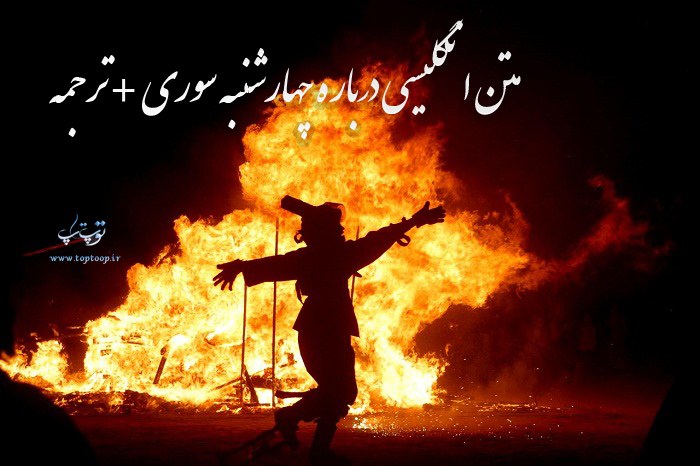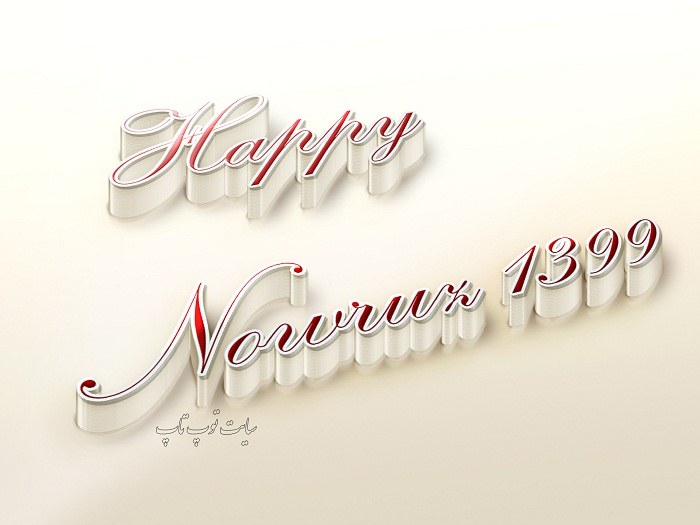متن انگلیسی درباره چهارشنبه سوری + ترجمه

آخرین چهارشنبه سال است و گرامیداشت آتش، آتشی که جان میبخشد و نور، بدی را میبرد و شادمانی به همراه میآورد. در غروب آخرین سه شنبه سال، شوق کنار هم بودن و جشن و سرور داریم تا کینه ها را بسوزانیم با دلی آکنده از مهر و خوشی به استقبال سال نو برویم. اما بیایید بخوانیم و بدانیم قصه ی این شب کهنسال را...
چهارشنبه سوری در آخرین چهارشنبه سال هنگام تکاپو برای نو شدن سال برگزار میشود. ایرانیان در شب آخرین چهارشنبه سال با روشن کردن آتش و پریدن از روی آن به استقبال بهار میروند. سور در معنای شادمان، رنگ سرخ، بارو و شهر و بام بلند و حتی دیوار دور شهر آمده است. اما به قطع یقین چهارشنبه سوری یعنی جشن و شادی و سرور در هر چهارشنبه ی آخر سال . در مورد وجه تسمیه « چهارشنبه سوری » عقیده بر این است که به مناسبت آتش افروزی، آن شب را « سور » ( سرخ ) نامیده اند. اما چرا چهارشنبه؟ آیا دلیل برگزاری جشن در این روز راندن نحسی و بدی در روز چهارشنبه بوده است؟ در پاسخ به این پرسش باید گفت که ایرانیان نه تنها چهارشنبه، بلکه هیچ روزی را خود به خود نحس یا بدیوم نمی دانستند و هنوز هم نمیدانند. در باورهای ایرانی هر روز سال به یکی از ایزدان منتسب و گرامی داشته میشده است. به ویژه زمان پایانی سال که زمان بازگشت روان و فروهر در گذشتگان به شمار می آمده و آیین های بسیار زیبا و با شکوه در استقبال نمادین آنان برگزار میکرده اند. باورهایی این چنین به فرهنگ های وارداتی دیگر وابسته است. به یک عقیده دیگر ایرانیان مراسم آتش افروزی در آستانه سال نو را پس از قبول اسلام، در آخرین چهارشنبه سال قرار داده اند، تا از عقیده اعراب پیروی کرده باشند که روز چهارشنبه یا « یوم الاربعا » را شوم و نحس می دانستند. روشنی و آتش، نور و خورشید، همیشه مظهر زندگی و رویش و بالیدن بوده است. این عنصر نزد ایرانیان بسیار مقدس و محترم بود. چنانچه آن را تجلی وجود خداوند میدانستند. به همین جهت در ستایش و بزرگداشت و تجلیل آن به هر شیوه و راهی که میشد اقدام میکردند. آتش میان همه تیره ها و اقوام آریایی از احترام و ستایش ویژه برخوردار بود و امروز اثرات آن در همه ادیان و و سنن قومی و جشن های ویژه مردم سراسر زمین آشکار است. روشنی آتش و آفتاب تجلی اهورا مزدا است. اهوارا مزدا به وسیله نور تجلی میکند. ایرانیان از دیرباز هنگامی که میخواستند ستایش خداوند را انجام دهند به سوی خورشید میایستادند. هر گاه شب هنگام بود، در جایی سربسته(آتشکده)، نماز می گزاردند و ستایش پروردگار می نمودند. رو به آتش فروزان که با بوهای خوش فضا را معطر میساخت می ایستادند. در اوستا آتش همه جا دارای مقامی والا است. گوهر زندگی و عشق است و تجلی خداوند. از این رو همه سنت ها، ترانه ها، باورها و مراسمی که مردمان نواحی گوناگون در شب چهارشنبه سوری انجام میدهند با وجود تفاوت هایی که با یکدیگر دارند در یک ویژگی با هم، همسانند، "راندن ناپاکیها و بدیها توسط آتش". ترانه ها و باورهایی که به بلاگردانی، راندن چشم شور، گره گشایی، آجیل مشکل گشا، بخت گشایی دختران و امثال این میپردازند.
"زردی من از تو ، سرخی تو از من " از جمله اشعاری است که پدربزرگ ها و مادربزرگ های امروز که همانا جوانان دیروز هستند، با نام ”چهارشنبه سوری“ با خود زمزمه میکنند. این عبارت در حقیقت نوعی عبارت دعایی محسوب میشود که در آن از آتش خواسته میشود تا شادابی و گرمای خود را به مردم داده و در عوض بیماری، مشکلات و گرفتاریها را از آنها بگیرد آنچه مسلم است، چهارشنبه سوری منحصر به آتش افروزی نیست، بلکه در روزگاران گذشته این مراسم با آیینهای دیگری همچون خوردن غذا به صورت دسته جمعی، سردادن سرودهای ویژه، قاشقزنی، فالگوش، بازیهای گروهی و نمایش های سنتی همراه بود.
چهارشنبه سوری در ایران آئین و تشریفات منحصر به خود را دارد. چیزی که از چهارشنبه سوری در همه شهرها و روستاهای ایران سراغ داریم به این صورت است که بیرون از خانه، جلوی در، در فضایی مناسب آتش میافروزند و اهل خانه زن و مرد و کودک از روی آتش میپرند و با گفتن زردی من از تو، سرخی تو از من بیماری ها و نگرانی ها و ناراحتی سال کهنه را به آتش میسپارند. آن بخش از آئین چهارشنبه سوری که در تمام ایران رواج دارد از کرمان گرفته تا آذربایجان و از خراسان تا خوزستان و از گیلان تا فارس یعنی تمام آنچه امروزه به عنوان فلات ایران شناخته میشود از زیباترین بقایای ایران باستانی است.
تمام ایران، شب چهارشنبه سوری آتش می افروزند زن و مرد و پیر و جوان چه در حیاط خانه چه در کوی و برزن و اماکن عمومی از روی شعله های فروزان آتش میپرند و شادی و سلامتی از آتش میطلبند.
آنچه مسلم است این است که آتش با قداست و نور زندگی افزا مظهر نیکی و سلامت است. آتش بدی را در خود میسوزاند. آتش غم و اندوه را در خود میسوزاند. آتش زندگی می بخشد و نوید خوشی میدهد. صدای طبیعت است که سرما را پشت سر گذاشته و جانی دوباره گرفته است. هر آیین و آدابی که در این شب برگزار میشود با این عقیده همراه است که بدی و غم و میرود و خوشی پا در خانه ها میگذارد. شاید به همین دلیل است که شاهد کوزه شکنی یا فالگوش هستیم. چنانکه در گذشتههای نه چندان دور مردم از بام خانهها بالا میرفتند و کوزه ای با خود میبردند که هرگز با آب پر نشده بود، کوزه را به زمین افکنده و می شکستند چرا که عقیده داشتند بلایا را در کوزه متراکم کرده اند و چون بشکنند بلا از آنها دور میشود. کسانی که حاجتی داشتند نیز نیت میکردند و بر سر گذری می ایستادند و به سخنان عابران گوش میدادند و معتقد بودند هر چه از دهان او برون آمد به فال نیک یا بد میتوان گرفت.
چهارشنبه سوری نیز مانند دیگر جشن های ایرانی، آواز طبیعت و نوای شادمانی است. زیبایی های آیین ایرانی را با هم به جشن و سرور می نشینیم و می خوانیم که تو ای آتش، تو ای بزرگترین سزاوار ستایش، فروزان بمان در این خانه همیشه و تا زمان بی پایان.
چهارشنبه سوریتان مبارک.
متن انگلیسی
It is the last Wednesday of the year and the commemoration of the fire, the fire that gives life and the light, destroys evil and brings happiness. At sunset on the last Saturday of the year, we have the enthusiasm to celebrate the New Year with a heart full of affection and joy. But let's read and know the story of this old night. Charshanbeh-suri is held on the last Wednesday of the year as we strive to renew the year. Iranians welcome spring on the last Wednesday of the year by lighting the fire and jumping over it. Sur means the sense of joy or red color. But to be sure, charshanbeh-suri means celebration and rejoicing every last Wednesday of the year. They believe in the deployment of "Chaharshanbeh Suri", which was called "Sur" (Red) that night because of the fire. But why Wednesday? Is there a reason to celebrate this day for evicting evil on Wednesday? In answer to this question, it should be said that Iranians didn’t know and still don’t, no day unlucky, not just Wednesday. In Iranian beliefs, every day of the year is attributed to one of the gods. Especially the end of the year, which marks the return of soul in the past, and they have held very beautiful and magnificent rituals in their symbolic welcome so these beliefs depend on other imported cultures. In other words, Iranians have set fire on the eve of the New Year after Islam on the last Wednesday of the year, to follow the beliefs of the Arabs who viewed Wednesday or Yom Al-Rabaa as sinister and scary. Light and fire, light and sun have always been the symbol of life and growth. They considered it a manifestation of the existence of God. So they did their best to praise and celebrate it in every way. The fire among all Aryan tribes was highly respected and today its effects are evident in all religions and ethnic traditions and special celebrations of people all over the earth. The brightness of the fire and sun is the manifestation of Ahura Mazda that is illuminated by light. The Iranians have long been standing in the sun when they wanted to praise God. Whenever it was night, they would pray in a closed place (Fire Temple) and praise the Lord. They were standing in the blazing fire that made the aroma of fragrant air. In Avesta, fire has a high sublime everywhere. It is the essence of life and love and the manifestation of God. Hence all the traditions, songs, beliefs and ceremonies that people of different regions perform on charshanbeh-suri despite the differences they have, are the same in one attribute “The elimination of impurities and evils by fire”. Songs and beliefs that deal with helplessness, evil eyes, or wishing happiness for single girls by marriage.
There is a poem that said “Get my Bumblebee, give your red color to my face” among the poems that today's grandparents, who are the youth of yesterday, are chanting on Charshanbeh-suri to fire. It is, in fact, a form of prayer and the fire is called upon to give people their joy and warmth, and to get sickness, troubles and afflictions instead. What is certain is that Charshanbeh-suri is not just about lighting a fire, Rather, it was accompanied by other rituals such as mass eating, special hymns, trick-or-treat, eavesdropping, group games, and traditional performances. Chaharshanbeh Suri in Iran has its own unique rituals and ceremonies. What we have learned about all the cities and villages of Iran on charshanbeh-suri is that there is a fire in a suitable space outside the house, in front of the door, The men, women, and children of the house jump from the fire, by singing “Get my Bumblebee, give your red color to my face” and burning the diseases and worries and worries of the old year. That part of charshanbeh-suri ritual that is prevalent throughout Iran, from Kerman to Azerbaijan and from Khorasan to Khuzestan and from Guilan to Fars, all of which is nowadays known as the Iranian Plateau, is the most beautiful remains of ancient Iran. All over Iran, on charshanbeh-suri, men and women, young and old, set the fire whether in the courtyard or in public places and they want happiness and health from the fire. What is certain is that fire with holiness and the light of life is a sign of goodness and health. Fire burns evil in itself, Burns sadness in itself and gives life and joy. It is the sound of nature that leaves the cold behind and is reborn. Every ritual held on this night is accompanied by the belief that evil and sorrow go away. And happiness walks into the houses. Maybe this is why we are seeing a jar breaking or eavesdropping. As in the not-too-distant past, people went to the roof and carried a jar that was never filled with water, threw the jar to the ground and broke it because they thought disaster is saved into the jar and it goes away by breaking jar. Those who had a wish were also intent on standing and listening to passersby, believing that whatever they say could be good or bad. Chaharshanbeh Suri, like other Iranian celebrations, is a song of nature and a sound of joy. We celebrate the beauties of Iranian ethic together. And we sing that you, fire, You deserve the greatest praise, Stay in this home forever and ever.
Happy Charshanbeh-suri
